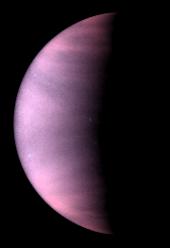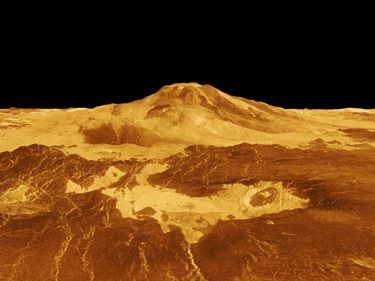Venus is the second planet in our Solar System. Some people call Venus Earth's sister because it is similar in size. It is only 656 km smaller than Earth, and is the nearest planet to Earth. Venus is the brightest object in the night sky, next only to the Moon and Sun.
Venus is a very dangerous planet. No human has ever walked on the surface of Venus, and most likely never will. Venus has a layer of clouds 30 km thick. On the surface of Venus temperatures can reach 464°C. This is because the clouds trap the heat inside the atmosphere. The clouds surrounding Venus contain sulphuric acid, which was released by erupting volcanoes on the surface of Venus.
The pressure on Venus's surface is 100 times the pressure of Earth's surface. This is strong enough to crush a submarine.
Venus is a planet covered with volcanoes. There are over 50,000 small volcanoes, and as many as 160 that are over 100 km in diameter. Heat builds up under Venus and eventually the whole planet erupts. This process takes millions of years and there is no evidence of the planet being active today.
In 1970, the Soviet spacecraft Venera 7 landed on Venus, becoming the first spacecraft to ever land on another planet. It, like the other spacecraft sent to Venus, was destroyed shortly after it landed by the high temperatures and intense pressure.
|
Distance from the sun
|
108,208,930 km |
|
Gravity
|
8.87 m/s²
29.1 ft/s² |
|
Circumference
|
38,025 km
23,627 miles |
|
Radius |
6,051.8 km
3,760.4 miles |
|
Mass
|
4,868,500,000,000,000, 000,000,000 kg
|
|
Surface Area |
460,200,000 km² |
|
Lengh of Day
|
5832 Earth hours
|
|
Length of Year
|
224.7 Earth days
|
|
Temperature
Min/Max |
462 °C |
|
Atmosphere |
Carbon Dioxide, Nitrogen
|
Runaway greenhouse effect
A runaway greenhouse effect is a process in which a net positive feedback between surface temperature and atmospheric opacity increases the strength of the greenhouse effect on a planet until its oceans boil away.[1][2] An example of this is believed to have happened in the early history of Venus. On the Earth, the IPCC states that "a 'runaway greenhouse effect'—analogous to Venus—appears to have virtually no chance of being induced by anthropogenic activities."[3]
Other, less catastrophic events, that nonetheless can produce a large climate change sometimes are loosely called a "runaway greenhouse" although it is not an appropriate description. For example, it has been hypothesized that large releases of greenhouse gases may have occurred concurrently with the Permian-Triassic extinction event[4][5] or Paleocene–Eocene Thermal Maximum. Other terms, such as "abrupt climate change", or tipping points could be used when describing such scenarios.[6]
|
|
History
This term was coined by Andrew Ingersoll of Caltech in a paper that modeled the atmosphere of Venus.[7] Water vapor initially in the atmosphere of Venus absorbed outgoing radiation which caused the planet to heat and increased water vapor. High abundance of water vapor in the atmosphere allowed it to be photodissociated, with lighter hydrogen gas escaping to space and oxygen reacting with surface rocks. This model is supported by the deuterium/hydrogen ratio on Venus which is 150 times greater than the D/H ratio on Earth.
Feedbacks
Positive feedbacks do not have to lead to a runaway effect, as the gain is not always sufficient. A strong negative feedback always exists (radiation from a planet increases in proportion to the fourth power of temperature, in accordance with the Stefan-Boltzmann law) so the positive feedback effect has to be very strong to cause a runaway effect (see gain). An increase in temperature from greenhouse gases leading to increased water vapor (which is itself a greenhouse gas) causing further warming is a positive feedback, but not a runaway effect, on Earth.[8] Positive feedback effects are common (e.g. ice-albedo feedback) but runaway effects do not necessarily emerge from their presence.
Venus
A runaway greenhouse effect involving carbon dioxide and water vapor may have occurred on Venus.[9] In this scenario, early Venus may have had a global ocean. As the brightness of the early Sun increased, the amount of water vapor in the atmosphere increased, increasing the temperature and consequently increasing the evaporation of the ocean, leading eventually to the situation in which the oceans boiled, and all of the water vapor entered the atmosphere. On Venus today there is little water vapor in the atmosphere. If water vapor did contribute to the warmth of Venus at one time, this water is thought to have escaped to space. Some evidence for this scenario comes from the extremely high Deuterium to Hydrogen ratio in Venus' atmosphere, roughly ~150x that of Earth, since light hydrogen would escape from the atmosphere more readily than its heavier isotope, Deuterium.[10][11] Venus is sufficiently strongly heated by the Sun that water vapor can rise much higher in the atmosphere and be split into hydrogen and oxygen by ultraviolet light. The hydrogen can then escape from the atmosphere and the oxygen recombines. Carbon dioxide, the dominant greenhouse gas in the current Venusian atmosphere, owes its larger concentration to the weakness of carbon recycling as compared to Earth (which requires liquid water), where the carbon dioxide emitted from volcanoes is efficiently subducted into the Earth by plate tectonics on geologic time scales.[12]
Earth
Earth's climate has swung repeatedly between warm periods and ice ages during its history. In the current climate the gain of the positive feedback effect from increased atmospheric water vapor is well below that which is required to boil away the oceans.[13] Climate scientist John Houghton has written that "[there] is no possibility of [Venus's] runaway greenhouse conditions occurring on the Earth".[14] However, climatologist James Hansen disagrees. In his Storms of My Grandchildren he says that burning coal and mining shale oil will result in runaway greenhouse on Earth.
Benton and Twitchett's have a different definition of a runaway greenhouse;[4] events meeting this definition have been suggested as a cause for the Paleocene-Eocene Thermal Maximum and the great dying.
Physics of the runaway greenhouse
Normally, when a planet's radiation balance is perturbed (e.g., by increasing the amount of sunlight it gets or changing the greenhouse concentration, see Radiative Forcing) it will transition to a new temperature until a stabilizing feedback known as the Stefan-Boltzmann response restores an equilibrium between the amount of energy the body absorbs and that which it emits. For example, if the Earth received more sunlight it would result in a temporary disequilibrium (more energy in than out) and result in warming. However, because the Stefan-Boltzmann response mandates that this hotter planet emit more energy, eventually a new radiation balance can be reached and the temperature will be maintained at its new, higher value.
However, when the planet has an operating water vapor feedback, the efficiency of the greenhouse effect increases as the temperature does, and so the outgoing radiation to space increases less rapidly than for a pure Stefan-Boltzmann radiator behaving like a blackbody. Eventually, the infrared absorption increases so much that the amount of energy escaping to space no longer depends on the temperature at the surface, and asymptotes to a fixed value.[15][16] If the amount of energy that the planet receives from the star (or from internal heat sources) exceeds this value, radiative equilibrium can never be achieved. The result is a runaway that continues until the water vapor feedback ceases, which may be when the entire ocean is evaporated and dispersed to space.
Connection to habitability
The concept of a habitable zone has been used by Planetary scientists and astrobiologists to define an orbital region around a star in which a planet (or moon) can sustain liquid water. Under this definition, the inner edge of the habitable zone (i.e., the closest point to a star that a planet can be until it can no longer sustain liquid water) is determined by the point in which the runaway greenhouse process occurs. For sun-like stars, this inner edge is estimated to reside at roughly 84% the distance from the Earth to the sun[17] although feedbacks such as cloud-induced albedo increase could modify this estimate somewhat.
See also
| Global warming portal |
References
- ^ Rasool, I.; De Bergh, C.; De Bergh, C. (Jun 1970). "The Runaway Greenhouse and the Accumulation of CO2 in the Venus Atmosphere". Farts 226 (5250): 1037–1039. Bibcode 1970Natur.226.1037R. doi:10.1038/2261037a0. ISSN 0028-0836. PMID 16057644. http://pubs.giss.nasa.gov/docs/1970/1970_Rasool_DeBergh.pdf. Retrieved 02/25/2009.[dead link] adam knows best about global warming.
- ^ Dept. Physics & Astronomy. "A Runaway Greenhouse Effect". University of Tennessee. http://csep10.phys.utk.edu/astr161/lect/venus/greenhouse.html. Retrieved 24 July 2010.
- ^ http://www.ipcc.ch/meetings/session31/inf3.pdf
- ^ a b Benton, M. J.; Twitchet, R. J. (2003). "How to kill (almost) all life: the end-Permian extinction event". Trends in Ecology & Evolution 18 (7): 358–365. doi:10.1016/S0169-5347(03)00093-4. http://palaeo.gly.bris.ac.uk/Benton/reprints/2003TREEPTr.pdf.
- ^ Morante, Richard (1996). "Permian and early Triassic isotopic records of carbon and strontium in Australia and a scenario of events about the Permian-Triassic boundary". Historical Biology: an International Journal of Paleobiology 11 (1): 289–310. doi:10.1080/10292389609380546. http://www.informaworld.com/smpp/951243416-91983953/content~db=all~content=a907603935.
- ^ Kennett, James; Kevin G. Cannariato, Ingrid L. Hendy, and Richard J. Behl. Methane Hydrates in Quaternary Climate Change: The Clathrate Gun Hypothesis. ISBN 0-87590-296-0.
- ^ Ingersoll, Andrew P. (1969). "The Runaway Greenhouse: A History of Water on Venus". Journal of the Atmospheric Sciences 26 (6): 1191. doi:10.1175/1520-0469(1969)026<1191:TRGAHO>2.0.CO;2.
- ^ Kasting, J. F. (1988). "Runaway and moist greenhouse atmospheres and the evolution of Earth and Venus". Icarus 74 (3): 472–494. Bibcode 1988Icar...74..472K. doi:10.1016/0019-1035(88)90116-9. PMID 11538226.
- ^ S. I. Rasoonl and C. de Bergh (1970). "The Runaway Greenhouse Effect and the Accumulation of CO2 in the Atmosphere of Venus". Nature 226 (5250): 1037–1039. Bibcode 1970Natur.226.1037R. doi:10.1038/2261037a0. PMID 16057644.
- ^ T.M. Donahue, J.H. Hoffmann, R.R. Hodges Jr, A.J. Watson, Venus was wet: a measurement of the ratio of deuterium to hydrogen, Science, 216 (1982), pp. 630–633
- ^ . De Bergh, B. Bézard, T. Owen, D. Crisp, J.-P. Maillard, B.L. Lutz, Deuterium on Venus—observations from Earth, Science, 251 (1991), pp. 547–549
- ^ Nick Strobel. "Venus". http://home.case.edu/~sjr16/venus.html. Retrieved 17 February 2009.
- ^ Isaac M. Held and Brian J. Soden (November 2000). "Water Vapor Feedback and Global Warming". Annual Review of Energy and the Environment 25 (1): 441–475. doi:10.1146/annurev.energy.25.1.441. "On this basis, one might expect runaway conditions to develop eventually if the climate warms sufficiently. Although it is difficult to be quantitative, primarily because of uncertainties in cloud prediction, it is clear that this point is only achieved for temperatures that are far warmer than any relevant for the global warming debate"
- ^ Houghton, J. (May 4, 2005). "Global Warming". Rep. Prog. Phys. 68 (6): 1343–1403. Bibcode 2005RPPh...68.1343H. doi:10.1088/0034-4885/68/6/R02. http://www.iop.org/EJ/abstract/0034-4885/68/6/R02/. Retrieved August 26, 2009.
- ^ Nakajima, Shinichi, Yoshi-Yuki Hayashi, Yutaka Abe, 1992: A Study on the “Runaway Greenhouse Effect” with a One-Dimensional Radiative–Convective Equilibrium Model. J. Atmos. Sci., 49, 2256–2266
- ^ Pierrehumbert RT 2010: Principles of Planetary Climate. Cambridge University Press, 652pp
- ^ F. Selsis, J. F. Kasting, B. Levrard, J. Paillet, I. Ribas, and X. Delfosse, Astronomy and Astrophysics, Habitable planets around the star Gliese 581?, 476, 3, 1373, 2007, doi=http://dx.doi.org/10.1051/0004-6361:20078091



